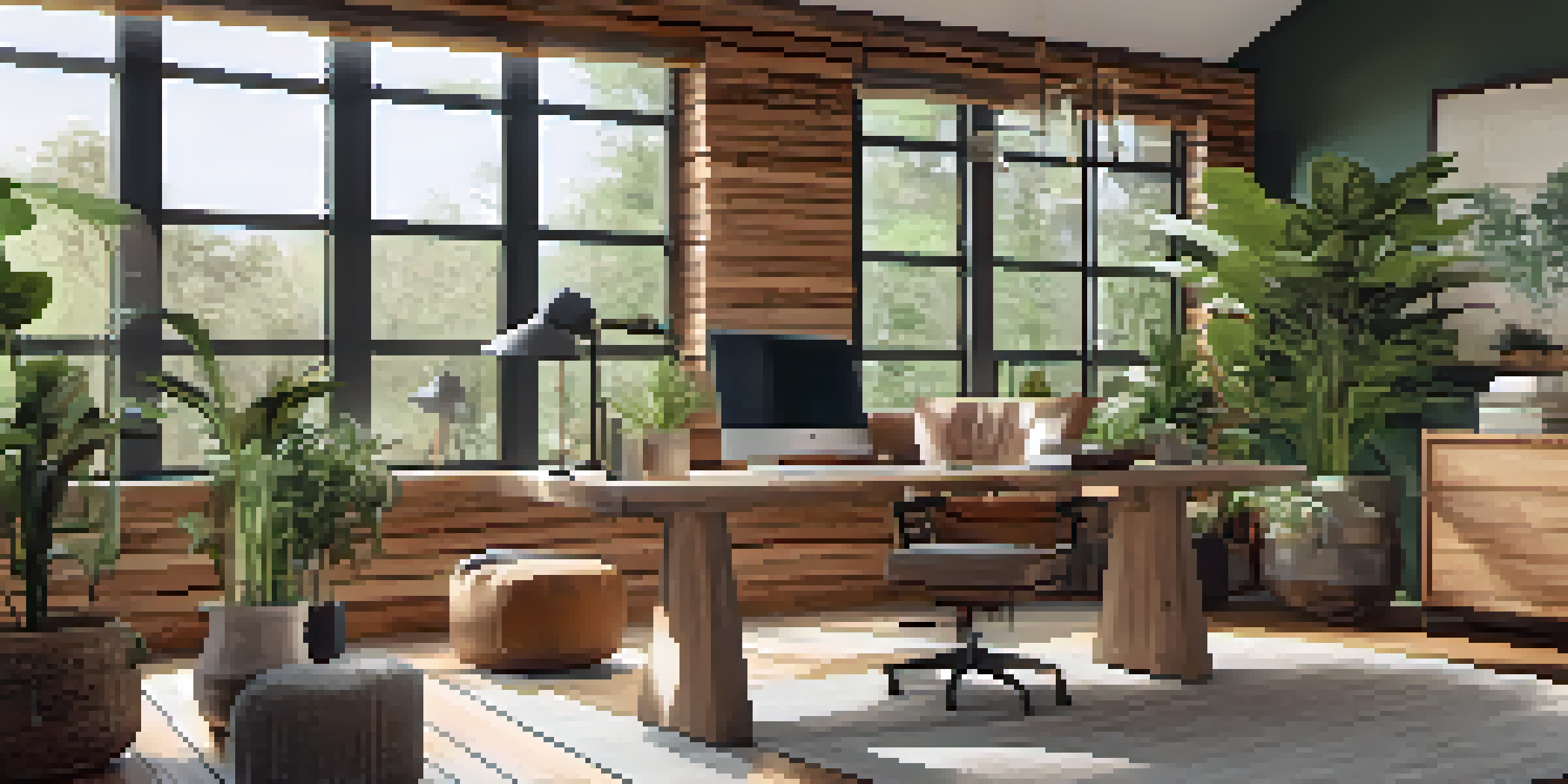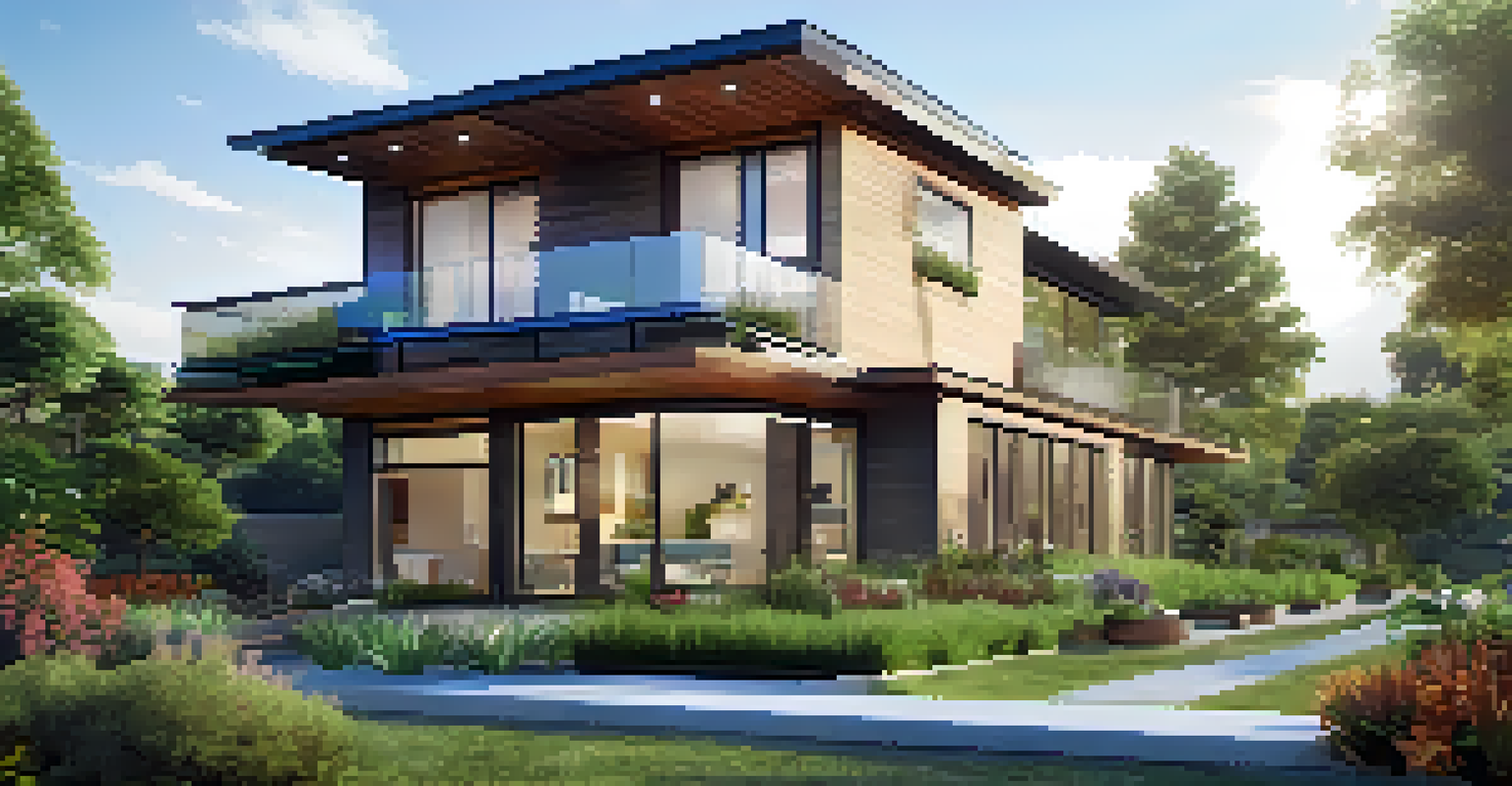Remote Work and Eco-Friendly Housing Trends: A New Era

The Rise of Remote Work: A Catalyst for Change
Remote work has surged in popularity, transforming how we view our jobs and homes. With more people working from home, the need for spacious, functional living environments has become paramount. This shift is not just about comfort; it's about rethinking the very essence of our living spaces to accommodate a work-life balance.
The future belongs to those who believe in the beauty of their dreams.
As employees adapt to this new normal, they're seeking homes that support productivity while being eco-conscious. This includes features like dedicated home offices and sustainable materials, which reflect a growing awareness of our environmental footprint. The blending of work and home life is pushing us to make greener choices.
Ultimately, remote work is redefining housing trends, encouraging a focus on sustainability. As more individuals prioritize eco-friendly features, builders and designers are taking notice, leading to innovative solutions that meet both professional and environmental needs.
Eco-Friendly Housing: A Response to Remote Work Needs
The shift toward remote work has sparked an increased demand for eco-friendly housing. Many individuals are now prioritizing homes that are not only functional but also sustainable. This includes energy-efficient appliances, solar panels, and smart home technology that help reduce energy consumption.

Moreover, the concept of green building has evolved to incorporate more than just materials; it also embraces the design and orientation of homes. For example, maximizing natural light can reduce reliance on artificial lighting, while thoughtful landscaping can enhance biodiversity. These features not only contribute to a healthier planet but also create a more enjoyable living environment.
Remote Work Drives Eco-Friendly Homes
The rise of remote work is increasing demand for sustainable living spaces that support productivity and environmental consciousness.
As remote work becomes the norm, the integration of eco-friendly housing features will likely continue to rise. Homebuyers are increasingly aware of the benefits of living in a sustainable space, which includes lower utility bills and a reduced carbon footprint.
The Importance of Location in Eco-Friendly Housing
Location plays a critical role in the appeal of eco-friendly housing. Many remote workers are choosing to relocate to areas that offer a blend of nature and community, seeking a lifestyle that prioritizes wellness. Access to green spaces, parks, and outdoor activities enhances the work-from-home experience.
Sustainability is not a trend; it is a responsibility.
Additionally, proximity to public transportation and local amenities is becoming more attractive. Living in a walkable community reduces reliance on cars, which contributes to lower emissions and a healthier lifestyle. As remote work allows for more flexible living arrangements, individuals are seeking neighborhoods that support sustainable living.
This shift in location preference highlights the broader impact of remote work on housing trends. It encourages developers to create eco-friendly communities that cater to the needs of remote workers while promoting sustainability at the same time.
Innovative Design Trends in Eco-Friendly Homes
Innovative design is at the heart of the eco-friendly housing movement. Architects and designers are increasingly focusing on creating spaces that are both beautiful and sustainable. Features like green roofs, rainwater harvesting systems, and energy-efficient windows are becoming standard in new builds.
Incorporating natural materials such as reclaimed wood and bamboo not only enhances aesthetics but also minimizes environmental impact. The goal is to create homes that harmonize with their surroundings, promoting a sense of peace and well-being for remote workers. These thoughtful designs reflect a commitment to sustainability without compromising comfort.
Location Matters for Remote Workers
Remote workers are seeking homes in communities that prioritize wellness, green spaces, and reduced reliance on cars.
Therefore, as remote work continues to shape our living environments, innovative eco-friendly designs are likely to gain even more traction. The marriage of functionality and sustainability is becoming a hallmark of modern housing.
The Role of Technology in Sustainable Living
Technology plays a vital role in promoting sustainable living, especially for remote workers. Smart home devices can monitor energy usage, allowing homeowners to make informed decisions about their consumption. From smart thermostats to energy-efficient lighting, technology is making it easier to maintain an eco-friendly lifestyle.
Moreover, advancements in renewable energy technologies, like solar panels, are enabling homeowners to generate their own power. This not only reduces reliance on fossil fuels but also lowers energy costs in the long run. Remote workers who invest in these technologies can create a more sustainable living environment that supports their lifestyle.
As we move into this new era, the synergy between technology and eco-friendly housing will continue to grow. Embracing innovative solutions can empower individuals to live sustainably while enjoying the comforts of modern living.
Community Initiatives Supporting Eco-Friendly Housing
Community initiatives are increasingly supporting the transition to eco-friendly housing. Local governments and organizations are launching programs to promote sustainable building practices and energy efficiency. These initiatives often provide resources, incentives, and support for homeowners and builders committed to green living.
Moreover, community gardens and shared green spaces are becoming more common, fostering a sense of belonging among residents. These initiatives encourage collaboration and provide opportunities for remote workers to engage with their neighbors, promoting a healthy lifestyle and community spirit.
Technology Enhances Sustainable Living
Smart home devices and renewable energy technologies are facilitating eco-friendly lifestyles for remote workers.
As remote work reshapes our living arrangements, the importance of community-driven efforts cannot be overlooked. These initiatives not only enhance the appeal of eco-friendly housing but also cultivate a culture of sustainability.
Future Prospects: Remote Work and Sustainable Housing
Looking ahead, the future of remote work and sustainable housing seems promising. As more companies adopt flexible work policies, the demand for eco-friendly housing is likely to increase. This shift presents a unique opportunity for builders and developers to create homes that cater to this new lifestyle.
Moreover, as awareness of environmental issues grows, so does the push for sustainable practices in housing. Innovations in construction materials and techniques are continually evolving, making eco-friendly options more accessible and affordable for everyone. The integration of these practices into mainstream housing could lead to significant improvements in our overall environmental impact.

In conclusion, the intersection of remote work and eco-friendly housing marks the beginning of a new era. By prioritizing sustainability, we can create living environments that not only support our professional needs but also help protect our planet for future generations.